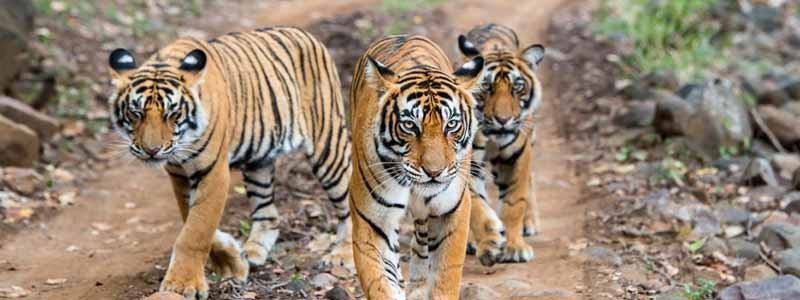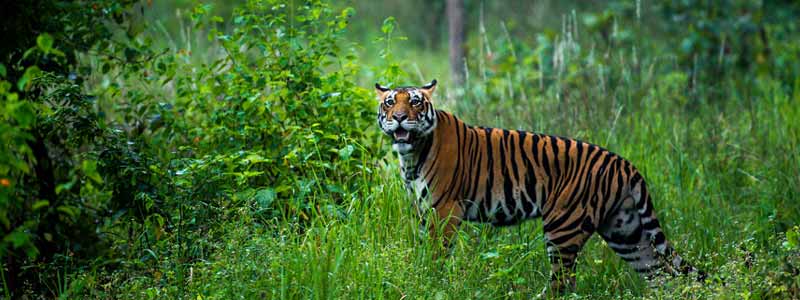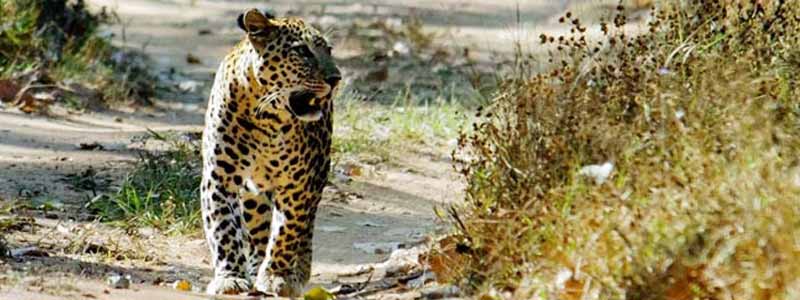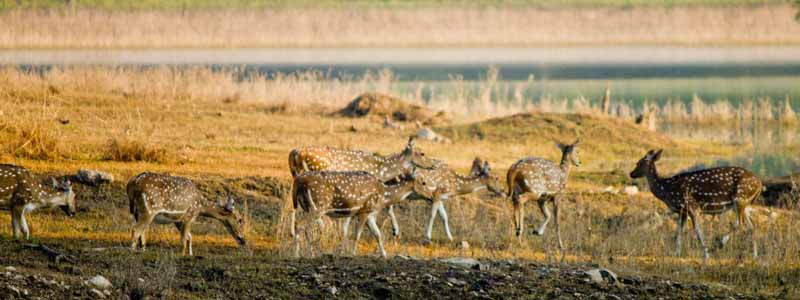Pench National Park is a renowned wildlife sanctuary located in central India, straddling the border of the states of Madhya Pradesh and Maharashtra. Covering an area of approximately 758 square kilometers, the park is named after the Pench River that winds its way through its lush forests, creating a picturesque landscape.
This biodiverse haven is a treasure trove of flora and fauna, providing a habitat for a rich variety of wildlife. It is famously known for its population of Bengal tigers, which draw wildlife enthusiasts and researchers from around the world. In addition to tigers, the park is home to an impressive array of wildlife including leopards, wild dogs, Indian bison (gaur), sambar deer, spotted deer, and a diverse bird population, making it a paradise for nature lovers and birdwatchers alike.
The landscape of Pench National Park is a mosaic of tropical dry deciduous forests, open grasslands, and meandering streams. The park’s topography is marked by hills, valleys, and a network of seasonal water bodies, creating a dynamic environment that supports a wide range of species.
Visitors to Pench have the opportunity to explore the wilderness through guided safaris, providing a chance to witness the park’s charismatic inhabitants in their natural habitat. The morning and evening safaris offer distinct experiences, with the chance to observe different wildlife behaviors.
Conservation efforts in Pench National Park are focused on preserving the delicate balance of its ecosystem. The park’s management works tirelessly to combat threats such as habitat fragmentation, poaching, and human-wildlife conflicts Rajasthan wildlife Tour Package.
Overall, Pench National Park stands as a testament to the incredible biodiversity of India and the efforts being made to safeguard its natural heritage. It provides a valuable space for research, education, and ecotourism, ensuring that future generations can continue to marvel at the wonders of this unique wilderness.

History of Pench National Park
Pench National Park, situated in the central Indian states of Madhya Pradesh and Maharashtra, boasts a history intertwined with both natural and cultural significance. The region’s legacy dates back to ancient times, with mentions of the Pench River appearing in ancient Sanskrit texts.
During the 17th century, the area surrounding Pench was under the rule of the Gond Dynasty, an indigenous group of people. They were known for their harmonious coexistence with nature and were among the earliest conservationists in the region. Later, in the 19th century, the area fell under British colonial rule Rajasthan Budget Tours.
The formal establishment of Pench as a national park occurred in 1975, although its history as a wildlife refuge goes back further. Inspired by Rudyard Kipling’s famous “The Jungle Book,” the park’s landscape served as the setting for his beloved tales. This literary connection has further enhanced the park’s fame and allure.
In 1992, Pench National Park was designated as a “Tiger Reserve” to bolster conservation efforts for the endangered Bengal tiger, which has been a cornerstone of the park’s ecological importance. The reserve designation brought about increased protection and resources for the park’s flora and fauna.
Pench’s conservation history has been marked by dedicated efforts to combat poaching and habitat degradation. The park’s management, along with various conservation organizations, has worked tirelessly to safeguard the park’s diverse ecosystem.
Today, Pench National Park stands as a beacon of successful wildlife conservation. It draws researchers, nature enthusiasts, and tourists from around the world, offering them the chance to witness India’s rich biodiversity in action. With its captivating history and ongoing conservation efforts, Pench remains a testament to the enduring relationship between humanity and the natural world.

Flora and Fauna in Pench National Park
Pench is gifted with jungles extended in all of its directions. According to physiognomy, the jungle kind is southern humid, also dry teak. Southern steamy is mixed by deciduous jungle along with various shrub species, climbers and trees. Pench National Park is quite prosperous in fauna as many endangered wildlife inhabit here.
In Pench there are more than 55 big cats along with 39 different mammals, 13 reptile races, about 03 amphibian species and approximately 210 species of birds.

Best Places to Visit Nearby Pench National
Pench National Park is surrounded by several interesting places that offer a mix of natural beauty, cultural heritage, and wildlife experiences. Here are some of the best places to visit nearby Pench National Park:
Nagzira Wildlife Sanctuary: Located just a few hours away from Pench, Nagzira Wildlife Sanctuary is another haven for wildlife enthusiasts. It is known for its lush greenery, diverse flora and fauna, and a variety of wildlife, including tigers, leopards, sloth bears, and numerous bird species.
Kanha National Park: Approximately 200 kilometers from Pench, Kanha National Park is one of India’s largest and most well-known tiger reserves. It’s renowned for its tiger population, as well as its picturesque landscapes, including dense forests and grassy meadows.
Satpura Tiger Reserve: Satpura Tiger Reserve, situated about 250 kilometers from Pench, offers a unique and relatively unexplored wildlife experience. It is known for its diverse topography, which includes deep valleys, high mountains, and dense forests. You can enjoy boat safaris and walking safaris here, making it different from many other national parks in India.
Ramtek Temple: Ramtek, located around 60 kilometers from Pench, is a historic town known for the ancient Ramtek Temple. This temple holds great religious and cultural significance and offers panoramic views of the surrounding landscape.
Seoni: Seoni, located near Pench, is a quaint town known for its connection to Rudyard Kipling’s “The Jungle Book.” Visit the Seoni Hills, which are believed to be the inspiration for Kipling’s settings in the book.
Pachmarhi: Situated at a considerable distance from Pench (around 350 kilometers), Pachmarhi is a hill station known for its lush greenery and scenic beauty. It offers a pleasant climate and numerous viewpoints, waterfalls, and caves to explore.
Tadoba Andhari Tiger Reserve: A bit farther from Pench (approximately 300 kilometers), Tadoba Andhari Tiger Reserve is another excellent destination for wildlife enthusiasts. It’s one of Maharashtra’s oldest and largest tiger reserves and is known for its tiger sightings.
Khajuraho: Although a bit of a drive (about 400 kilometers), the UNESCO-listed Khajuraho Group of Monuments is worth visiting for its stunning temples adorned with intricate erotic sculptures.
When planning your visit to these places near Pench National Park, be sure to consider the distances, local weather conditions, and any permits or reservations required for wildlife safaris or temple visits. Each of these destinations offers a unique experience, whether you’re interested in wildlife, history, or natural beauty.

Best time to visit Pench National Park
October to February can be considered the best time to visit Pench when the weather is pleasant and the jungle looks lush. However, November to March could be the best months for bird watching when birds come to central India from colder areas to spend winter. You should avoid Monsoon season if you are looking forward to jungle safari as it is kept closed for the safety of both tourists and animals.
How to reach Pench National Park
Pench National Park is located in both Madhya Pradesh and Maharashtra, India. It is accessible from several major cities and towns in both states. Here are the general directions for reaching Pench National Park:
By air: Dr Babasaheb Ambedkar International Airport in Nagpur and Jabalpur Airport are the two best options for travel if you decide to take a flight to Pench. Jabalpur airport is situated at approximately 213 kilometres away and can only be utilised by domestic flyers, the Nagpur Airport is situated at a distance of about 130 km and is seen to be an easy method to get if travellers are arriving from both domestic and international destinations. Taxis are fairly accessible from both airports and make for a nice ride to Pench.
By rail: Nagpur railway station is the closest railhead from Pench with good connectivity, and it is situated approximately 130 kilometres away. Another option is the Jabalpur railway station located at a distance of 210 kilometres. Both www.irctc.co.in and www.indianrail.gov.in allow for online details checking and train booking.
By road: The Nagpur-Jabalpur Highway can lead you to Pench Tiger Reserve. From Jabalpur or Nagpur, you can travel by road and it takes approx. three to four hours to get to Pench. Khawasa or Seoni are the closest bus stops to Pench, and hourly buses run from Nagpur.








